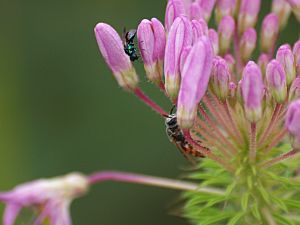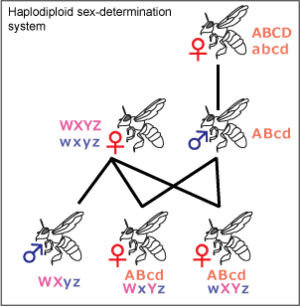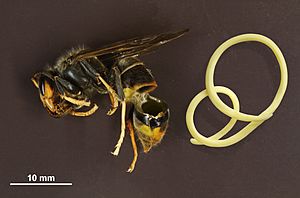Lasioglossum zephyrus facts for kids
Quick facts for kids Lasioglossum zephyrus |
|
|---|---|
 |
|
| L. zephyrus (top) with a cuckoo wasp | |
| Scientific classification | |
| Kingdom: | |
| Phylum: | |
| Class: | |
| Order: | |
| Family: |
Halictidae
|
| Genus: |
Lasioglossum
|
| Species: |
L. zephyrus
|
| Binomial name | |
| Lasioglossum zephyrus (Smith, 1853)
|
|
The Lasioglossum zephyrus is a type of sweat bee. It belongs to the Halictidae family. You can find these bees in the United States and Canada. Sometimes, its name is spelled "zephyrum" by mistake. This bee is known for being "primitively eusocial". This means that while they live in groups, their jobs in the colony are not always fixed. They can also sometimes live alone. These bees build their nests in burrows in the ground.
Contents
About the Lasioglossum zephyrus Bee
The Lasioglossum zephyrus bee is a fascinating insect. It has a shiny dark green body with a reddish belly. Its face is hairier than most other bees. Male bees are usually 6 to 7 millimeters long. They are a bit bigger than females. Males are also brighter green with redder bellies. It's hard to tell a worker bee from a queen bee just by looking. But queens act differently. They push other bees around in the nest. They also nudge them to stop them from laying eggs.
Where L. zephyrus Bees Live
You can find L. zephyrus bees all over the United States. They are active from March to October. They usually build their nests in April. These nests are often found along the sunny, south-facing edges of streams. Many nests can be grouped together. Sometimes, there are as many as 1,000 nests in one area.
Young female bees usually dig the burrows for the nests. Older females might help too if their nests get destroyed. They mostly dig at night. But you can see them working during the day too. Worker bees use their jaws to loosen the soil. Then, they carry it a short distance. Another bee might pick it up from there. This soil is used to smooth the burrow walls. It can also fill old, empty burrows. Females also dig special cells. They line these cells with a liquid from their bodies.
The L. zephyrus Life Cycle
Lasioglossum zephyrus nests are small. They usually have fewer than 20 bees. In the spring, around April, new nests are started. One or more female bees begin these nests. Some nests might stay small with just one bee. If a nest grows, it reaches its biggest size around August. This is usually 10 to 20 bees. The colony grows slowly throughout the summer.
Young queens that have mated stay in their nests over winter. This helps the cycle start again next year. However, queens that stay through winter often die early in the summer. When an old queen dies, a new queen takes over very quickly. L. zephyrus colonies can have a high death rate. This is especially true if a single bee lives there without guards.
Bee Behavior and Roles
Who's in Charge: Dominance in the Colony
In a L. zephyrus colony, roles are decided by age or size. But direct fights also determine who is in charge. This is different from some other bees. For example, Lasioglossum hemichalceum bees are more equal. All females in that species can reproduce. They also work together to raise their young.
Queens in L. zephyrus colonies push workers deep into the burrows. This stops workers from finding food. It also keeps their egg-laying parts from growing. This behavior is not affected by how closely related the bees are. But it does happen less over time. In colonies where bees are more closely related, there is less fighting. When the queen dies, another worker bee takes her place. She then starts laying eggs. Queens are at the top because their egg-laying parts are fully grown. Next are the guard bees, who have some egg-laying ability. Forager bees are at the bottom of the group.
Working Together: Division of Labor
Young female bees are in charge of building the nest. As adults, Lasioglossum zephyrus females become either queens that lay eggs or workers. Workers find food, guard the nest, and build cells. Usually, the oldest females in a colony are the mated queens. But if bees are the same age, the biggest one is usually the queen. After her first group of workers hatches, the queen stops collecting pollen or building cells. Queens and workers don't look very different. Their size changes gradually.
Male Bee Behavior
Male bees do not stay in their home nests. They are not considered helpful members of the nest. Instead, they form large groups around clusters of nests. They do this as early as two days after hatching. In early spring, males are alone or in small groups. But by late summer, they gather in groups of thousands of bees. In these groups, bees fly into each other. They are looking for females and flowers.
When looking for food, L. zephyrus males search for flowers. They sometimes even force flowers open. This lets them get the pollen first. Males have been seen landing on small rocks or objects. They act as if these are female bees. They have been seen mating as young as four days old. They mate until they die. In labs, males flew specific routes. They flew between certain objects in order. They sleep in holes, on plants, or in old burrows. They sleep alone or in small groups.
Stopping Reproduction: Reproductive Suppression
Most queens will mate during their lives. But some worker bees can also mate. They are physically able to do so. About 18% of workers successfully mate between June and August. When a queen is present, workers usually do not want to mate. Female bees have been seen eating the eggs of other nest mates. This stops them from reproducing. They also show aggressive behaviors, as mentioned in the dominance section.
How Bees Communicate and Recognize Each Other
Individual bees can recognize their nest and other bees in their nest. They do this by their smells. This helps stop other L. zephyrus bees or other species from being parasites. Both male and female bees can do this. Males can tell individual females apart by their unique smells. They learn to avoid females who do not want to mate. L. zephyrus bees have also been seen leaving other nests without being attacked. This supports the idea that they use smells to find their own nests.
Family Ties: Kin Selection
How Bees Are Related
In Hymenoptera species, like Lasioglossum zephyrus, females have two sets of genes (they are diploid). Males usually have one set of genes (they are haploid). This system is called haplodiploidy. However, in some L. zephyrus groups, males with two sets of genes have been found.
Worker bees in these species are expected to be very closely related to each other. This is if the queen mates only once. But in studied nests, the relationship was found to be a bit lower. This might be because queens mate with more than one male. Because they are so closely related, worker bees are likely to help each other a lot. Workers share only half of their genes with the queen. So, they share more genes with their sisters. Workers are more closely related to their sisters than to their own children. This is one reason why workers do not mate often. They can pass on more genes by helping their sisters. Nests that are close to each other tend to be more genetically similar.
Recognizing Family
Once a bee learns the smell of its family, it can recognize relatives it has never met. This is because smells are determined by genes. Bees can also tell if a relative is close or distant. Learning helps with family recognition. But the genetic differences in smell are more important. Recognizing family helps protect the whole nest. It also helps individual bees. Bees benefit by only helping their related nest mates.
What L. zephyrus Bees Eat
Adult Lasioglossum zephyrus bees feed their young pollen from nearby plants. They visit many different flowers. So, they collect many types of pollen. Some pollen has more protein than others. But the adult bees do not change how much they feed based on pollen quality. All young bees get the same amount of pollen. This means the young bees grow to different sizes.
Being larger is good for female bees. It gives them a better chance of becoming a queen. They also tend to lay more and better quality eggs. Being larger also helps females survive the winter. Larger male bees are better at defending areas. They are also better at competing for mates. Size also helps both male and female bees fly. A larger body size means a higher body temperature. This allows them to fly earlier in the season and more often. These bees have been seen forcing open unopened flowers of the Xyris tennesseensis plant. This lets them get the pollen first and keep it for themselves.
Enemies and Interactions
Parasites of L. zephyrus
L. zephyrus bees can be attacked by many different organisms. These include bacteria, fungi, tiny protozoa, and other types of wasps and bees. Tiny worms called Nematodes have been found inside the bodies of female L. zephyrus bees. These worms can stop the bees' egg-laying parts from growing. Parasites that attack in the spring, when nests are being started, are often the most successful.
If threatened, a bee might try to attack or even cut off the head of an intruder. Guard bees often protect the nest. One guard bee might attack while others block the entrance with their bodies.
Nests with only infected female bees are in danger of dying out. Infected bees can still dig burrows. But they are less active than healthy bees. They also do not collect pollen to make cells.
A type of protozoa called Gregarine has been found in older L. zephyrus bees. It is thought that it takes time for these parasites to fully develop once a bee is infected. These parasites have only been found in female bees. It is not clear why male bees are not affected.
The bee species Lasioglossum cephalotes is a kleptoparasite of L. zephyrus. This means it steals food or resources from L. zephyrus. The mutillid wasp Pseudomethoca frigida is also a parasitoid. It is known to fight aggressively with female L. zephyrus bees. Instead of stinging, L. zephyrus tries to cut off the wasp's head. The mutillid wasp then retreats, unable to defend itself.



